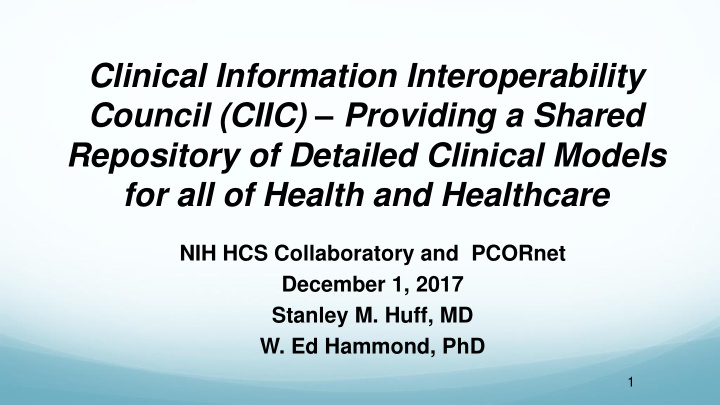



Clinical Information Interoperability Council (CIIC) – Providing a Shared Repository of Detailed Clinical Models for all of Health and Healthcare NIH HCS Collaboratory and PCORnet December 1, 2017 Stanley M. Huff, MD W. Ed Hammond, PhD 1
Agenda • Why? • What we want to do • How? • Questions, comments, and discussion
Why?
Why? “To help people live the healthiest lives possible.”
Patient 5
Core Assumptions ‘ The complexity of modern medicine exceeds the inherent limitations of the unaided human mind.’ ~ David M. Eddy, MD, Ph.D. ‘... man is not perfectible. There are limits to man’s capabilities as an information processor that assure the occurrence of random errors in his activities.’ ~ Clement J. McDonald, MD 6
Eileen
Why? • We need to • Provide better care • By sharing executable clinical decision support modules • Decrease cost • By providing better care • By eliminating point-to-point mapping of data elements • Make clinicians and patients happier • Provide accurate computable data as the foundation of a learning health system (LHS)
What we want to do
What • We want to create ubiquitous sharing of standardized data across the breadth of medicine for: • Direct patient care • Patient entered data and outcomes • Research and learning • Public health • Clinical trials • Data from devices • Post market surveillance • Quality and disease specific registries • Billing and health administration • Any where that we share health related data and information …..
Make a shared repository of Detailed Clinical Models (aka a logical models) SystolicBPObs SystolicBP data 138 mmHg LOINC or SNOMED Observable quals BodyLocation BodyLocation Right Arm data SNOMED CT PatientPosition PatientPosition Sitting data 11
What The models are used during software development, which makes the process much faster and more efficient, and it insures that the references to data in the software adhere to the agreed standards.
Logical Model Development Lifecycle Standards Infusion Core Reference Model SNOMED CT LOINC SystolicBPObs SystolicBP HL7 FHIR RxNorm 138 mmHg data LOINC or CDISC SNOMED Observable quals CEMs BodyLocation HL7 CDA BodyLocation Right Arm data Translators Model Review DCMs X12 SNOMED CT PatientPosition PatientPosition Repository of CDA NCPDP Shared Models Templates data in an approved Sitting Formalism openEHR HL7 V2 Archetypes ISO EN 13606 FHIM FHIR Archetypes Models Resources Initial Loading of Repository Model Dissemination
The Interoperable App Development Process Create Domain Logical Approve Model Analysis Models Models Repository (CIMI) Project Needs Terminology Create Physical • Pediatric Growth Chart Server Artifacts (FHIR • Neonatal Bilirubin (SOLOR) Profiles) • Comm Acq Pneumonia • OPA Data Collection • MQIP • ACC registries Create Artifact Conformance Software Repository Testing (Apps, (FHIR Profiles) Services, CDS)
The ultimate value of detailed information models • Software is developed much faster • Clinical knowledge is contained in the models • Much easier for software engineers • The data used in the applications is completely conformant to standards, leading to semantic interoperability • If you follow the SMART on FHIR development strategy, your software can be shared with any system that supports the approved standards
Three related but very different questions • What data should be collected? (part of domain analysis) • It will be different for different situations • How should the data be modelled? • Two fields or one (the degree of pre and post coordination) • What does the data mean? • How do we make computable definitions for diabetes mellitus, myocardial infarction, heart failure, chronic renal failure, etc.
How?
How • All stakeholders agree to work together • Have practicing front-line clinicians direct the work • Capitalize on the work in existing projects • Agree to use a common format for representing the models • Use and share common tools to create the models • Share the models through an open internet accessible repository • Approve one preferred model for a given kind of data in a given situation • Use existing models whenever possible
CIIC 2017 Meeting Overview July 13, 2017
Summary of the July 13 th meeting in Bethesda • Keynote speaker – Don Rucker, MD (National Coordinator for HIT) • About 120 attendees • Representing – AAN, AAO, ACOG, ACS, ACC, ACP, APTA, ANA, FDA, CDC, NCI, AHRQ, NIAID, DoD, VA, PCPI, AMIA, SPM, HIMSS and many other organizations • Meeting outcomes • CIIC should continue • Create mission, vision, a plan for initial governance • Develop a mailing list and a discussion forum • Projects • ACOG – OPA – FPAR, Cancer DTR, MDEpiNet RAPID, Vital Signs, Skin and Wound Assessment, PCPI Registries on FHIR, … • Upcoming meetings • December 5-7 in New Orleans with HL7 Partners in Interoperability • January 10-12 at LDS Hospital in Salt Lake City
The END (or maybe the beginning?) Contact Information: Stan.Huff@imail.org 21
Recommend
More recommend